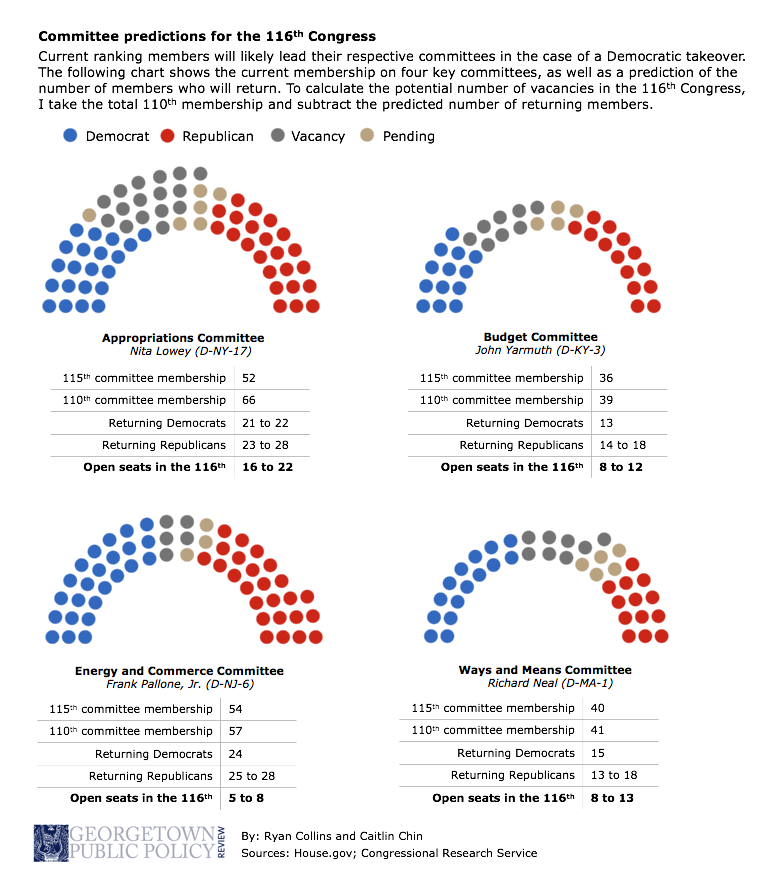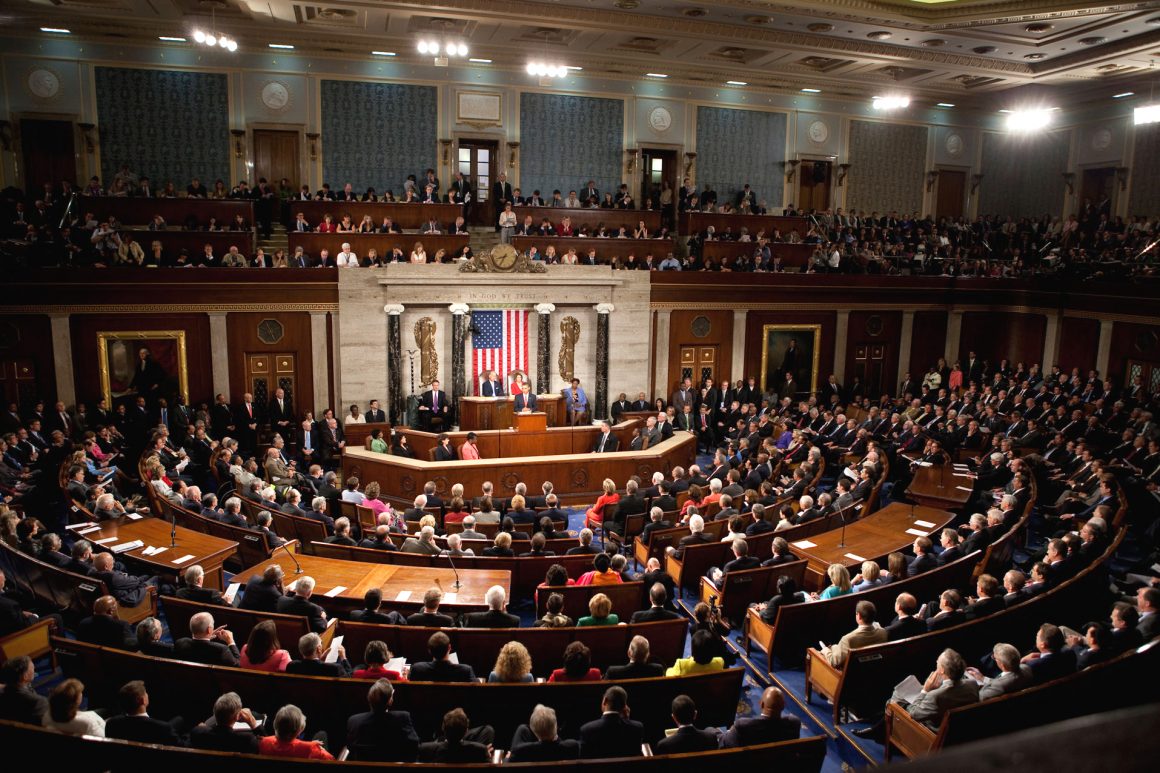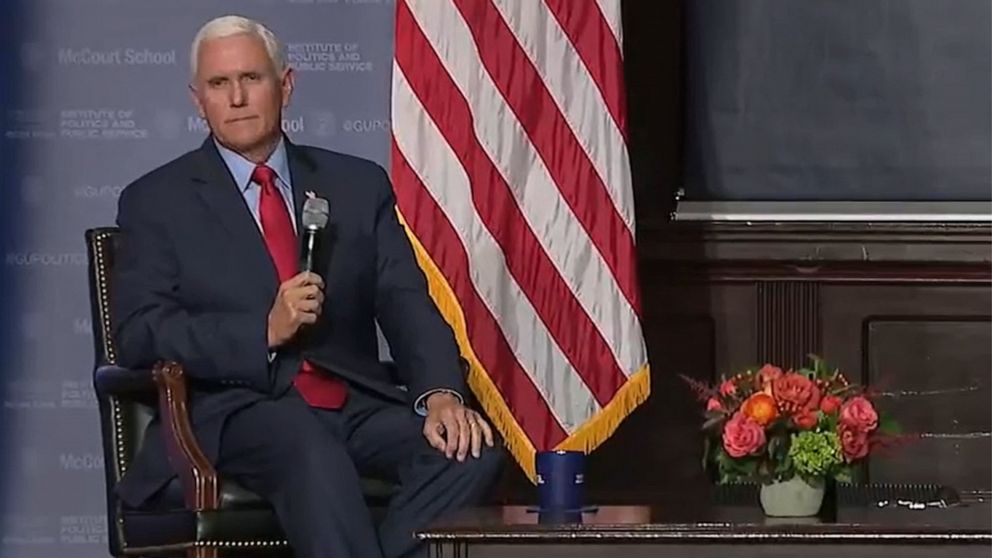With the 2018 midterm elections only a week away, the public is starting to imagine what the 116th Congress might look like. In particular, lobbying firms and political action committees have started hiring new staff members and writing campaign checks to prepare for a potential leadership change in one or both chambers. This original analysis examines the current state-of-play of the upcoming midterm elections and the possible membership and legislative priorities of the 116th Congress.
Districts up for reelection
Will the blue wave make land? The Republican Party currently holds a majority in the House of Representative, with 248 out of 435 seats. While every member of the House is up for reelection – and preliminary polls indicate relatively strong Democratic electoral support – not every district is in danger of flipping. The Cook Political Report estimates that incumbents will safely hold 334 out of 435 districts, and only rates 106 races as potentially competitive (compared to Larry Sabato’s Crystal Ball which rates 112 districts as competitive).
Using original analysis based on the five criteria below, I identify the districts most likely to turn blue and how this would impact Democrats’ legislative priorities should they win the House. Although sources such as Cook and Crystal Ball differ in opinion on which districts are most competitive, both Democratic and Republican congressional campaign committees generally target the districts they believe are likely pickups. This analysis will focus on the 104 districts which the Democratic Congressional Campaign Committee (DCCC) has identified as the most competitive.
Criteria for predicting an aggregate House win-margin
I’ve identified five criteria for predicting a district which has the potential to be a Democratic pick up based on the district’s partisan environment, candidate’s campaign strength, and specific district characteristics that highlight the underlying demographic picture.
- General ballot trends: This election cycle, Democrats have held a clear but fluctuating advantage in the generic ballot – a common polling question which compares a generic Democrat to a generic Republican (without any candidate identification). The current RealClearPolitics generic estimate is Democrat +7.2 percent and the current FiveThirtyEight estimate is D +8.4 percent, averaging D +7.8 percent. I then compare the generic to Cook and Crystal Ball scores, which measure a district’s political environment. For both Cook and Crystal Ball, tossup districts receive a baseline score of zero, negative scores lean Democratic, and positive scores lean Republican. Since the generic is favorable to Democrats this year, a district with a political score below seven (for Cook) or four (for Crystal Ball– same method but different spread) could flip into Democrat control.
- Fundraising CoH: A candidate’s fundraising demonstrates electoral support and could provide a potential campaign advantage. Therefore, it is important to identify Democratic candidates who have a Cash on Hand (CoH) advantage as of the most recent campaign finance filings. While CoH is not a perfect indicator, it provides a good overall estimate for fundraising strength.
- Population density: District type (urban, suburban, or rural) is an important demographic component that can contribute to a candidate’s success. Geographic political divisions are exacerbated by growing evidence of a rural-urban political realignment. Given the recent growth of Democratic support in urban and suburban communities (and policies that may negatively impact these areas), I flag districts based on population density. Moreover, the urban-rural divide is likely one of the leading political dynamics of our time and could explain the potential divergent outcomes between the House and Senate this year.
- Education levels: I flag districts with a higher than average percentage of residents with bachelor’s degrees (the national average is approximately 32 percent). There is strong evidence showing education levels are predictive of voting tendencies. Moreover, educated voters are souring on Trump, giving Democrats an edge where there are larger concentrations of educated voters.
- Minority residents: I also flag districts that have a higher than average population of non-white residents (the national average is 24 percent). This could help indicate political performance, as these communities are trending towards Democrats by wide margins.
Next, I filter the DCCC’s target district list to identify districts that exhibit at least two or three of these criteria as districts that are likely to elect a Democrat to the 116th Congress.
Results
Out of the DCCC’s 104 target districts, 45 districts currently meet at least three of the five criteria. An additional 19 districts meet two of these criteria, which potentially puts those districts within reach for Democrats. Democrats currently hold seven of the 104 districts; of the seven, I determine that five currently meet the three-criteria benchmark, one would meet two criteria, and one (PA-17) is a partisan wash due to a recent redistricting case.
Using the above benchmark, I predict that Democrats could pick up between 44 and 63 districts, flipping the House in their favor. This conclusion aligns with relatively well with other analyses, including FiveThirtyEight, The Economist, and general favorability on the PredictIt markets. With an additional 44 to 63 Democratic members of Congress, the potential Democratic House majority could fall in the realm of 237 to 256 seats. The average of these potential high and low Democratic majorities is 247 Democratic seats, or a 59-seat majority.
More GPPR articles on the 2018 midterm elections:
Comparing the 116th Congress to the 110th
While committee membership and ratios are highly speculative before an election, historical congressional makeups could offer a comparison. For instance, the Congressional Research Service’s report on House party ratios demonstrates an 110th congressional makeup roughly equivalent to the predicted 116th. Therefore, the 110th Congress could serve as a useful proxy to base congressional assumptions on.
For historical context, the 110th Congress followed the 2006 Democratic wave, which led to Rep. Nancy Pelosi’s speakership and gave Democrats control of the chamber after 12 years in the minority. In the 110th Congress, Democrats controlled 233 seats, (14 off from the predicted 116th average above) giving them a vote margin of 31. Moreover, some analysts suggest that Pelosi could lead the chamber again next year.
Potential legislation for the next Congress
Congressional candidates have laid out their likely priorities for office through their campaign promises. Democrats, in particular, are campaigning on healthcare, infrastructure, and labor issues, as well as investigations into the Trump administration. Accordingly, the primary committees to watch are the Appropriations, Budget, Energy and Commerce, Transportation and Infrastructure, and Ways and Means Committees. Politico names several current ranking members who could potentially chair these committees, including Rep. Frank Pallone to lead Energy and Commerce and Rep. Maxine Waters to lead Financial Services.

It is worth noting the sheer number of open seats per committee – Democrats could almost double their member numbers in many committees, which could impact the committee process in several ways. For example, committee chairs could consolidate power and gain rank and file followers. On the other hand, a large number of new members could potentially cause disorganization or lack of consensus. The manner in which chairs incorporate new voices and steer committees will prove pivotal to their success.
House Minority Leader Nancy Pelosi’s Dear Colleague Letter provides a roadmap for Democrats’ legislative goals, including calls for lowering health care costs, increasing wages while rebuilding America, and cleaning up corruption.
Given that the Democrats’ final campaign message has focused on Republican efforts to dismantle the Affordable Care Act, it’s no surprise that healthcare and drug pricing top the list of priorities. One could expect bills regarding drug importation, Medicare/Medicaid, reinsurance, and market stabilization to make their congressional debut. It is also likely that Democrats will put together a package to invest $1 trillion in infrastructure, expand labor protections, increase the minimum wage, and create jobs. Democrats would likely move antitrust, anti-corruption, and campaign finance legislation, with the DISCLOSE Act as a potential model. Additionally, the majority of the caucus is overwhelming interested in tackling thorny immigration issues – particularly family separation and passage of the DREAM Act – and finding solutions on gun violence prevention.
All in all, a change is coming to the House of Representatives. All signs, including this analysis, point towards a major congressional shift in power, predicting new legislative priorities and oversight in January 2019. How newly minted Democratic members are able to harness and project their priorities will depend on how well they navigate old congressional dynamics.
Public domain photo via the Office of the Speaker.


